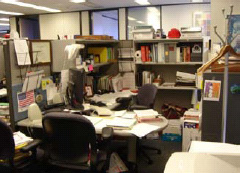Centralized Filing
Introduction
Filing documents is a task that all office workers struggle with. A poor filing system can lead to lost productivity when time is spent searching for relevant documents rather than focusing on work tasks. Careful analysis and good workplace design can help organizations improve the management of archival information anddata. Whether filing systems are simple or complex, the important factor is to develop the system based on strategic thinking about the workplace and the structure of organizational information.
What is Centralized Filing?
Centralized Filing is a system in which the records for several people or units are located in one, central location. Generally,access to the files is controlled by one or a limited number of people.. The central file system houses records that are of common interest or value and easily accessible to a number of employees or job functions.
Drivers for Change
The use of centralized filing is an increasingly common component of workplace redesign as individual workstations become smaller and more space is made available for collaborative activities. With a smaller individual space, there is less surface for piles and less storage space. Another driver comes from knowledge management. With the increasing need for good information flow, centralized filing becomes part of a system for maintaining, tracking and sharing up to date information.
Benefits of Centralized Filing
The benefits of centralized filing include:
- Reduced time spent searching for files.
- Improved security due to controlled access to files
- Improved space utilization.
- Simplified and more accurate maintenance.
- Reduced paper and printing costs.
In addition, the exercise of creating the files improves overall organizational awareness.
Managing the Change
Resistance to change in long ingrained habits may be difficult to overcome --many workers clearly prefer to have information close at hand and desire the space for paper documents.
- Locate files in an area that is readily accessible by all workers. Distance or other difficulties in obtaining files can result in resistance and increased proliferation of personal filing systems.
- Develop a system for handling files during off hours. Despite oversight by a full time staff member, documents may be inaccurately handled during off hours.
- Invest in more efficient filing equipment. This may add to the costs of implementation, but will make the system more effective in the long run.
- Consider hiring a professional firm to develop and manage the system. A professional firm will diagnose the current filing state and will work with the organization to create a a more effective system that all can easily use.
- Train workers, not only in how to use the central system, but also how to create more effective personal electronic files. People often keep hard copy files because they haven't developed good methods for storing and accessing computerized files.
Implementing A Centralized Filing System
The following steps are necessary for developing a centralized system.
- File review and reorganization: Research the most effective data base file and retrieval system for your purposes. Active documents are typically handled with high frequency and by multiple users, so it is vital that a tracking system be in place to record who has what documents and for how long. color-coding and labeling files still works effectively in some situations. There are also paper-tracking software programs to assist you in determining the most effective way to manage your newly centrally located files. Some more advanced systems utilize a bar code tracking system.
- Review all files and locate unfilled or hoarded documents.
- Open every filing cabinet and drawer
- Observe if there is an apparent system or rationale in place
- Become familiar with the subject matter in the files
- Determine degree of confidentiality required for files. For example, only the accounting personnel and human resources should have access to certain files and documents. Careful consideration must be given to which files are appropriate for general viewing.
- Decide which files should be archived or destroyed, rather than filed in a central location
- Separate the categories of material Like a traditional library, it is important to label your information appropriately. Although your needs may constitute different categories, some sample ones include:
- Legal –attorney correspondence, litigation, contracts, etc.
- Financial –assets and liabilities
- Resources –clippings, brochures, catalogs, newsletters
- Administrative –Marketing, licenses, advertising, personnel, clients
Consider Infrastructure Issues
A centralized filing room creates special weight problems and careful structural analysis is important to assure that the floor can support the weight of the files. If not, you may need to install extra structural support. If you are relocating to a newly constructed space, it would be useful to inquire about the load rating for the floors. If you have a choice of locations, choose one adjacent to a bearing wall. Also, ensure the room housing the files is fireproofed.

